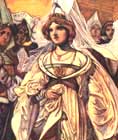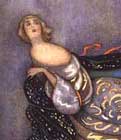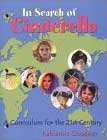
Cinderella:
345 Variants
by Marian
Roalfe Cox
SurLaLune's
Cinderella Area
SurLaLune Fairy Tales Main Page
275
Blade, Jean-Francois, Contes populaires recueillis en Agenais. Paris,1874. Pp. 1-8. (Narrated by Catherine Sustrac.)
"PEAU D'ANE."
ABSTRACT
Voice from nut-tree threatens father if he does not give one of his three daughters to marry king of France. Eldest daughter refuses --Voice threatens again. Second daughter refuses-- Voice threatens third time. Youngest daughter consents conditionally--Counter-tasks--Magic dresses--Heroine also demands gold plate, goblet, knife and fork, and golden spinning instruments--King leaves bride after church ceremony. If he should not return in nine years she must seek him--After eight years and one month bride begins quest. Finds ass skin--Heroine disguise--Washerwomen direct her to church where king of France is being married.--As recompense heroine washes sooty cloth white--Heroine meets king leaving church; asks if he remembers what he said to her father. Priest adjures him to confess if previously married. King says no. Bride engages heroine as turkey-girl--Menial heroine--Heroine bribes queen with golden gifts and magic dresses, and three nights sleeps with king, who has had sleeping draughts and does not hear her questions. Third night he has less potent draught and replies. Queen sent to her own home with bribes--Happy marriage.
TABULATION
(1) Father of three daughters is one day working in the field, when voice from nut-tree says, "Unless you give me one of your daughters in marriage I shall devour you." Father asks who speaks; voice replies, "I am king of France." Father promises one of his daughters should she consent.-- (2) Father goes home and to bed. Eldest daughter asks what ails him. Father says she can cure him by marrying king of France; but she will not. Next day father returns to work in field, voice accosts him as before, and he says eldest daughter refuses, but he will ask second. Returns home and goes to bed.-- (3) Second daughter tends him, but declines to marry king of France. Next day, when father goes to work, and voice threatens him as before, he promises youngest daughter, and returns home and goes to bed.-- (4) In order to cure father, youngest daughter consents to marry king of France, but he must first give her a dress like the sky, another like the moon, a third like the sun, also a golden plate and goblet, and a knife and fork of gold; a golden t and twelve golden spindles with the gauge-plate (filiere). "You shall have them all," says the king of France, who is listening at the door.-- (5) Presents arrive next day, and marriage is celebrated in a fortnight.-- (6) On leaving church king tells bride he is setting out on a long journey, and if he does not return in nine years she must seek him. Bride waits eight years and one month, then begins quest. After three days she finds ass's skin in the road, and puts it round her.-- (7) In three more days she reaches stream where women are washing clothes, and inquires if they have seen king of France. They point to church in which he is being married to beautiful girl. Peau d'Ane thanks them, and in return for information offers to help wash. They give her a cloth black as soot, which she immediately renders pure white.1-- (8) Peau d'Ane then goes to church, meets king of France coming out, and asks if he remembers what he said to her father in the field (repeating his words). He does not answer, and she says the same again. Priest adjures him to con- less if he has been married before. King of France says No. Peau d'Ane is silent till bride comes out; then asks her if she wants servant ; is engaged as turkey-girl, and follows king and queen to castle.-- (9) Begs queen to let her sleep that night with king, and bribes' her to consent with gift of golden knife- and fork, and plate and goblet. All night she asks king if he remembers his words to her father (repeating them); but queen has given sleeping-draught' to king, and he does not reply.-- (10) Next morning queen sends her to mind turkeys till night, when again she obtains queen's permission to sleep with king, in return for golden trol, and twelve golden spindles and gauge-plate. All night she questions as before, but queen has again given him a sleeping-draught, and he does not answer.-- (11) Next morning Peau d'Ane is sent to mind turkeys; makes the same request at night, and gives queen the dresses like the sky and like the moon. Queen has given a less potent sleeping-draught to king, and when Peau d'Ane asks him if he remembers what he said to her father in the field, he replies, weeping, "Yes, I remember"-- (12) Next morning Peau d'Ane gets up, and when queen enters to send her after the turkeys, she finds her clad in robe like the sun. King says to her, "Queen, would you rather be a man's first or second wife?" "His first," she says. "Take then your golden knife and fork, plate and goblet; take the trol, and the twelve golden spindles, and gauge-plate; take the robe like the sky, and the robe like the moon, and return to your parents." And the queen goes to the stable, has the horse saddled, and returns to her home, while Peau d'Ane remains at the castle, and is queen in her stead.
NOTES
Note 13
(P. 171.) In the story of "Sigurdr, the King's Son", the princess gives precious articles to the bride for the privilege of sleeping with the prince, who, on the third night, throws away the sleeping-draught, and hears the princess recount her sorrows and sufferings on his account, and her despairing search for him. (Arnason, Icelandic Legends, p. 278.) The same incidents occur in "The Singing, Soaring Lark" (Grimm, No. 88), in "The Two Kings' Children" (No. 113), in "The Iron Stove'' (No. 127), and in "The Drummer" (No. 193); also in Dasent's "East o' the Sun and West o' the Moon"; in the Athenian folk-tale of "The Man made of Sugar", collected by M. Kampourales, and published in Transactions of the Historical and Ethnological Society of Greece, Athens, 1883 (see Folk-lore Journal, ii, 237); in the Chilian story of "Prince Jalma" (Folk-lore Journal, iii, 293); and in de Gubernatis, S. Stefano, No. 14. A sleeping-draught is given to the prince in the "Story of the Enchanted Youth" (Payne, i, 59); see also Benfey, Pant., i, 255. Compare "L'Oiseau Bleu" of Mme. d'Aulnoy, and see Campbell, iv, 294.
The following story has the bribes and sleeping-draught incidents, as well as the washing task; and has other points of resemblance with Cinderella tales:--
ROBERT CHAMBERS, Popular Rhymes of Scotland. 1870. Pp. 95-99.
"THE BLACK BULL OF NORROWAY."
Heroine rides on back of bull, eats out of its "right lug", drinks out of its "left lug", and sets by her leavings. Bull fights the devil till all is blue. Heroine, overjoyed at bull's victory, inadvertently moves one foot, forgetting injunction not to stir, and the bull in consequence cannot find her again. Heroine comes to foot of glass hill; serves a smith for seven years, so as to get airn shoon. In these she climbs hill, washes the bluidy sarks for washer-wife, who tells the young knight her eldest daughter has washed them, and he must in consequence marry her. Heroine bribes false bride with jewels found in magic fruits, and passes three nights in bridegroom's room. On the third night he pours away the sleeping-draught that the washerwife had given, and hears heroine's song. Washerwife and daughter are burnt.
In "The Red Bull of Norroway", pp. 99- 101, a variant of the above, there is no magic food-supply. After travelling on the bull's back through many dreadful forests, and arriving at a noble castle, heroine draws a pin from bull's hide, transforming him to handsome prince, who disappears suddenly. Heroine sets out in quest of him, suffers many hardships, gets three magic nuts from an old wife, and eventually using them as bribes, as in the foregoing story, she marries the Duke of Norroway, whom she has a second time delivered.
There is a beautiful Cupid and Psyche story about a monkey-faced prince in Fleury's Litterature orale de la Basse-Normandie ( ague et Val-de-Saire), Paris, 1883, pp. 135-50. It may be cited here as a variant of No. 275:--
"LE PAYS DES MARGRIETTES" (Marguerites).
Prince will lose his monkey face fifteen days after his marriage. He is to choose a wife for himself, but will have none of all those who by their manner seem to despise him, and chooses a little peasant girl. She drops some hot grease on him, while admiring his beauty, for at night he has a lovely face and he is doomed to leave her; such is the spell. She sets out in search of him, wanders far, and at length reaches the Castle of the Daisies, where her husband is about to wed the young châtelaine. Heroine changes dresses with a shepherdess, and gets employed at the castle as turnspit. She peels the three chestnuts given her by an old woman she met en route, and they are transformed into golden spinning-wheel, golden distaff, and golden spindle. With these she bribes the châtelaine, and sleeps three nights with prince, her own husband. The first two nights he has sleeping-draught administered by châtelaine's mother; on the third night he throws it away, and recognises his own wife. On the morrow, when all assemble for the wedding of prince and châtelaine, he relates a strange thing that has happened to him, He had lost the key which opened his secretary, had a new one made, then found the original. Which key ought he henceforth to use? All say "the original". Then he will follow their advice; and he shows the turnspit, whom he lost, then found again, and whom he will reinstate, being guided by their counsel.
(Told by Mother Georges, who did not know why the castle is called "des Margriettes" or paquerettes rouges.)
There are points of resemblance also in the following:--
S. CHELCHOWSKI, Powiesci i opowiadania ludowe z okolic Przasnysza (Contes et legendes du peuple des environs de Przasnysz [government of Plock]), Warsaw, 1889. Vol. i, pp. 138-55.
"O KARLINIE" (History of Caroline).
Heroine delivers king's son from the hands of the devil (a very long story). King's son wants to marry her, but queen-mother, by means of charms, destroys his memory, and would marry him to another. Heroine, who is called Caroline, tries to prevent this marriage; she possesses dresses like the moon, the stars, etc., but each time she comes to the castle they give prince a sleeping-draught. Counselled by an old woman, who is a fairy, heroine dons guise of beggar, and writes a letter to Charles, who recognises her, and returns to her.
A sleeping-draught is administered to the heroine by her
stepsisters in No. 119, and to the unnatural father
in No. 200, when, disguised as a merchant, he comes
to murder heroine's children. The bribes and sleeping-draught occur also
in No. 191. A sleep-bramble is used in one Icelandic
tale; a sleep-thorn in another (Arnason, pp. 411, 441). Odin sticks the
thorn in Brunhild's garment only, and throws her into a sleep. "Dorn-roschen"
is sent to sleep by the prick of the spindle. There is a "pin of
slumber" in Hyde's Beside the Fire, p. 39.
Return to place in text.
Cox, Marian Roalfe. Cinderella: Three Hundred and Forty-five Variants of Cinderella, Catskin, and Cap O' Rushes, abstracted and tabulated. London: David Nutt for the Folklore Society, 1893.
While the original text of this book is out of copyright, the special formatting and compilation available on SurLaLune Fairy Tales is copyrighted. Be aware that while the original content has been honored, page numbering, footnote numbering, redesigned charts, links, and other aspects are unique to this site's version of the text. Use at your own risk. For private and fair use educational purposes only.
©Heidi
Anne Heiner, SurLaLune Fairy Tales
E-mail: surlalune@aol.com
Page last updated February 1, 2006
www.surlalunefairytales.com










